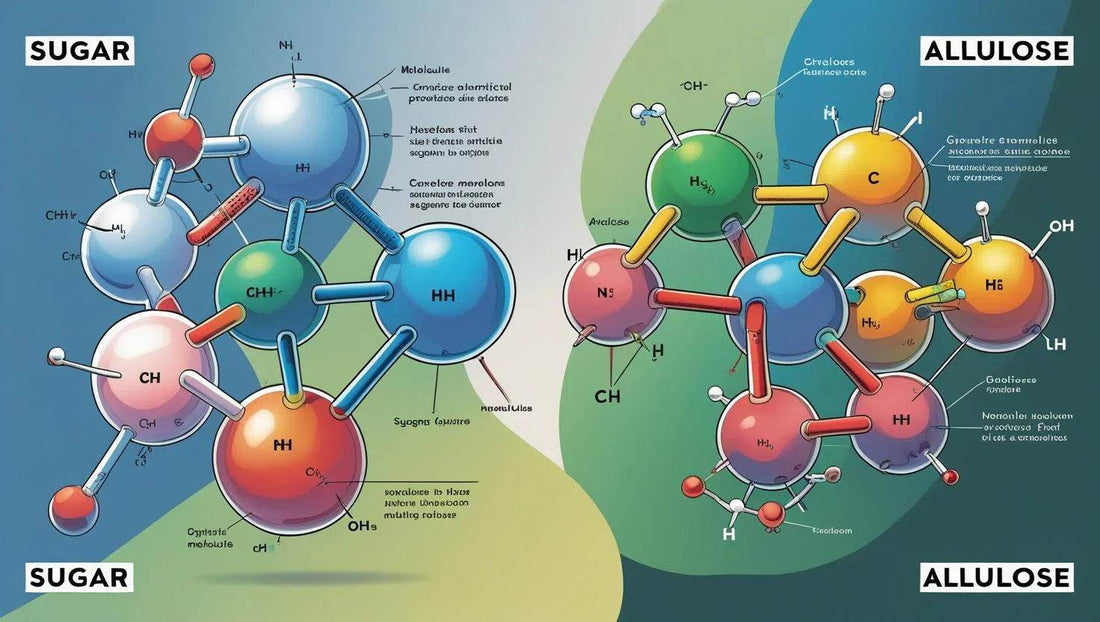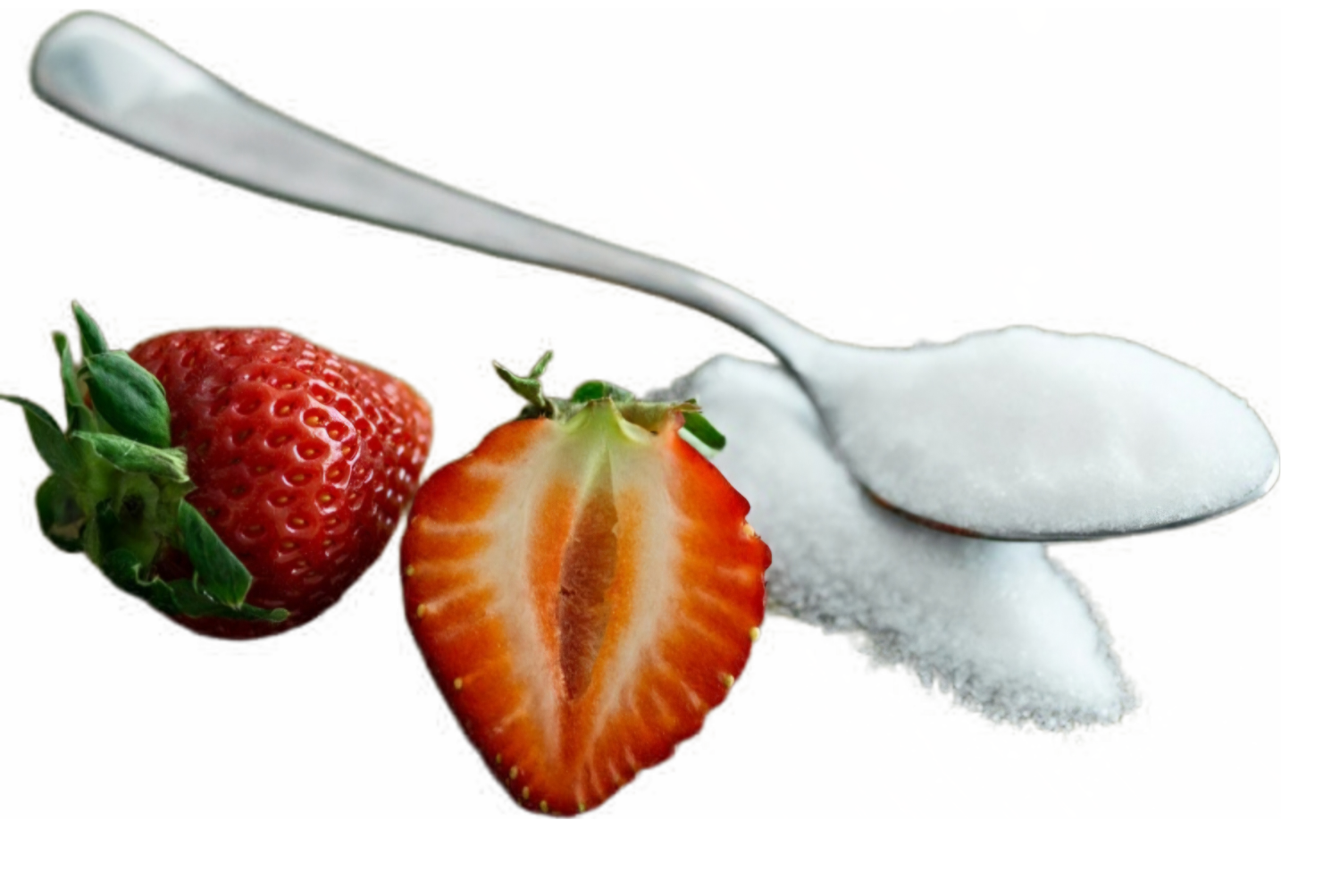
Allulose
Allulose StoreIt is made from a sugar called D-psicose, so it is a natural sugar .
Since the body does not recognize it as a carbohydrate, it does not have a glycemic or insulin-raising effect, meaning it does not cause blood sugar or insulin levels to spike.
What's more, it also reduces the glycemic response to high-glucose carbohydrates !
It has 70% of the sweetness of sucrose.
The body absorbs allulose but does not metabolize it into glucose, making it virtually calorie-free.
Moreover, when allulose enters the body, it displaces fructose and thus the negative effects of fructose cannot appear - fat, glycation, oxidative stress, plaque, ...
When subjects were given allulose along with their carbohydrates, their blood sugar and insulin levels decreased by 30% within two hours!
This is because the presence of allulose impairs the absorption of other sugars through the intestinal mucosa.
Both compete for the same sugar-transporting enzyme!
α-Glucosidase 1 is an important carbohydrate-degrading enzyme found in the brush border of the small intestine.
Its main function is the final step in the digestion of carbohydrates, during which it breaks down complex carbohydrates into simple sugars.
Reduces blood sugar levels in a dose-dependent manner
In one study, adding 7.5-10 grams of allulose to 50 grams of sucrose significantly reduced blood sugar levels 30 minutes after consumption.
Consumption of allulose led to significant reductions in body weight and body fat %, as well as improvements in insulin resistance and glucose metabolism .
It can increase fat burning , as less cholesterol allows fat cells to be used.
Allulose has an effect on free radicals and oxidative stress
Sugar increases the level of free radicals in the cells lining our arteries, but if we add allulose to the sugar, everything will be as if the person had not received any sugar.
This means that allulose inhibits the formation of inflammatory markers that could lead to plaque formation.
Approximately 80% of the total glycogen content of the human body is found in skeletal muscles.
In an adult's body, about 50 dkg of glycogen is stored in the muscles and about 10 dkg in the liver. This represents about 2000+400 kcal of energy.
It has been reported that rodents fed allulose have increased exercise performance and reduced recovery time because it increased the storage capacity of muscle and liver glycogen stores .
Long-term effects
- stimulates liver glycogen synthesis, which reduces blood sugar levels
- increases muscle strength and muscle mass
- accelerates the replenishment of liver and muscle glycogen after exhausting muscle activity
- reduces muscle autophagy (self-eating)
- protects the insulin-producing beta cells of the pancreas
- reduces the accumulation of triglycerides (fat cells) in the liver
- reduces blood lactate (lactic acid) levels after exercise, which slows down fatigue and increases physical performance and endurance (max. aerobic performance +13-25%)
Lactate is a byproduct of anaerobic metabolism.
Under normal circumstances, the blood lactate level is 1-2 mmol/L.
During intense physical exertion, lactate levels increase.
Lactate accumulation is associated with fatigue and decreased performance.
The anaerobic threshold
the exercise intensity where lactate production exceeds the rate of removal.
It is often used in athletes to evaluate performance and training effectiveness.
High lactate levels (>4 mmol/L) reduce performance and accelerate fatigue.
Lower lactate levels indicate better endurance and sustained performance over a longer period of time.
At an older age
the effect of allulose may be relatively greater as it can counteract the decline in performance associated with age .
In a study
48-week-old (middle-aged) mice given allulose supplementation showed increased quadriceps muscle mass and grip strength compared to the control group.

The mechanism of action of allulose for increasing muscle mass and strength:
- increases the expression of insulin-like growth factor 1 (IGF-1) and downstream factors related to protein synthesis
- inhibits myostatin, which is associated with protein breakdown
- regulates the mTOR signaling pathway and reduces autophagy (self-eating) in muscles
- increases the activity of antioxidant enzymes
These results suggest that allulose may improve age-related sarcopenia (muscle loss) by enhancing antioxidant properties and altering mRNA and protein expression.
Allulose therefore affects autophagy in a complex way, primarily reducing it in muscles, which may contribute to the preservation of muscle mass and strength, especially in older age.
Allulose also has dental benefits, as it is less likely to cause tooth decay than traditional sugar.
The body does not process it, so most of the allulose we consume is excreted.
It can be useful for diabetics and those who want to maintain stable blood sugar levels.
Manufacturing process
1. Starting material:
Allulose is usually produced from corn starch or fructose obtained from sugar beets.
2. Enzymatic conversion:
Fructose is converted into allulose using a special enzyme called D-psicose-3-epimerase (DPEase).
This enzyme modifies the structure of fructose, but does not change its sweet taste.
3. Cleaning and filtering:
The converted solution is filtered and purified to remove residual fructose and other impurities.
4. The liquid thus obtained is sold as syrup or crystallized and marketed as such.
Sustainability and benefits
Enzymatic production is more environmentally friendly than the production of sugar substitutes by chemical means.
Non-GMO versions are also available.
It is stable and heat-resistant, so it is suitable for baking and cooking.


